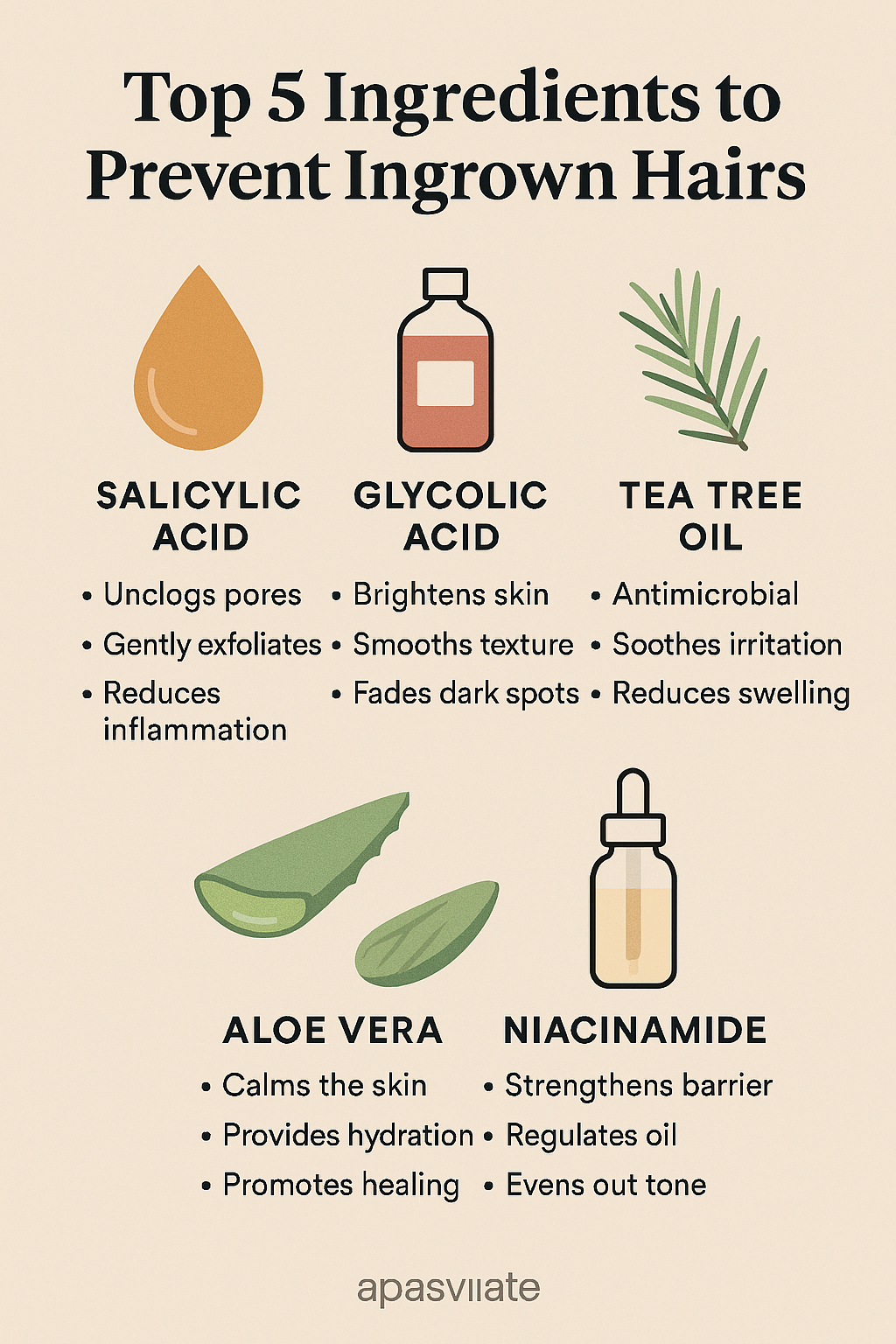Smooth, bump-free skin starts with understanding why ingrown hairs happen and choosing the right actives to stop them before they even begin. In this guide, we’ll dive deep into the top five ingredients proven to prevent ingrown hairs, explain how they work, and show you exactly how to use them for maximum benefit. By the end, you’ll have a clear routine and insider tips to transform your post-hair removal care—and keep your skin looking flawless all year round.
Why Ingrown Hairs Form
Ingrown hairs occur when a hair shaft grows sideways back into the skin instead of emerging through the pore. Dead skin, tight clothing, or improper hair removal techniques can trap the hair beneath the surface, leading to:
- Red, itchy bumps (razor bumps)
- Dark spots or hyperpigmentation
- Inflammation and potential infection
- Frustration and self-consciousness
Preventing ingrown hairs is about keeping pores clear, softening hair shafts, and calming inflammation. Let’s explore the five powerhouse ingredients that tackle each of these factors head-on.
1. Salicylic Acid: The Deep-Cleaning Exfoliant
Salicylic acid (a beta hydroxy acid, or BHA) is oil-soluble, so it penetrates deep into the pore to dissolve dead skin cells and excess sebum that trap hairs.
Benefits
- Unclogs pores and prevents follicle blockages
- Gently exfoliates without over-drying
- Reduces redness and calms inflammation
How to Use
- Choose a 1–2% salicylic acid cleanser or leave-on lotion.
- Apply once daily after cleansing.
- Leave on for 2–3 minutes before rinsing (if rinse-off), or follow product instructions for leave-on formulas.
- Always follow with a hydrating moisturizer and SPF in the morning.
2. Glycolic Acid: Brightening and Softening
Glycolic acid (an alpha hydroxy acid, or AHA) exfoliates the skin’s surface, sloughing away dead cells that can trap regrowing hairs and lead to bumps.
Benefits
- Speeds cell turnover for a smoother skin texture
- Fades post-inflammatory hyperpigmentation
- Boosts collagen production over time
How to Use
- Use a 5–10% glycolic acid toner or serum 2–3 times per week at night.
- After cleansing, swipe toner over the area or massage serum in with upward motions.
- Wait 5 minutes before layering heavier creams.
- Patch-test first if you have sensitive skin.
3. Tea Tree Oil: Natural Antimicrobial Defense
Tea tree oil offers powerful antibacterial and anti-inflammatory properties, helping to disinfect follicles and calm irritation before bumps form.
Benefits
- Kills bacteria that can infect ingrown hairs
- Soothes redness and itching
- Helps reduce swelling around follicles
How to Use
- Dilute 1–2 drops of tea tree oil in a teaspoon of carrier oil (e.g., jojoba or sweet almond).
- Apply with a cotton swab directly onto problem areas once daily.
- For a lighter dose, look for body washes or lotions with 0.5–1% tea tree extract.
4. Aloe Vera: Soothing Hydration
Aloe vera gel is a hydrating superstar that softens both skin and hair, making it easier for hairs to grow out rather than curl back in.
Benefits
- Instantly cools and calms irritated skin
- Locks in moisture without clogging pores
- Promotes healing of minor bumps and redness
How to Use
- Choose 100% pure aloe vera gel or a product with at least 70% aloe extract.
- Apply a thin layer all over shaved or waxed areas.
- Reapply after each hair removal session and as needed for dryness or irritation.
5. Niacinamide: Strengthening and Brightening
Niacinamide (vitamin B3) reinforces the skin barrier, improves texture, and helps regulate oil production—all key to preventing ingrown hairs.
Benefits
- Balances sebum production to reduce pore congestion
- Minimizes redness and supports barrier repair
- Lightens dark spots left behind by healed bumps
How to Use
- Incorporate a 5% niacinamide serum into your morning routine.
- After cleansing and toning, apply 2–3 drops and gently press into skin.
- Follow with moisturizer and SPF.
How to Build Your Ingrown-Free Routine
- Cleanse Gently
Use a sulfate-free, pH-balanced cleanser to remove dirt without stripping your skin. - Focus on Exfoliation
Alternate salicylic and glycolic acid products—salicylic in the morning, glycolic at night. - Target with Actives
Apply tea tree oil and niacinamide serums on problem zones for antimicrobial and barrier-boosting support. - Soothing Hydration
Lock in moisture and calm any lingering redness with aloe vera. - Protect & Maintain
Always finish with broad-spectrum SPF 30+ during the day. Reapply every two hours if you’re outdoors.
Frequently Asked Questions
- Can I use all five ingredients every day?
It’s best to stagger exfoliants. Use salicylic acid daily (if tolerated), glycolic acid 2–3 nights per week, and spot-treat with tea tree oil, niacinamide, and aloe vera as needed. - What if my skin becomes irritated?
Scale back to every other day for exfoliants, and always follow with a gentle, fragrance-free moisturizer. - How long until I see fewer bumps?
Most people notice improvements in 2–4 weeks with consistent use. Hyperpigmentation may take 8–12 weeks to fade.
By combining these five powerhouse ingredients into a thoughtful, consistent routine, you’ll dramatically reduce—and eventually eliminate—the appearance of ingrown hairs. Start today and get ready to show off smooth, healthy skin that radiates confidence.
